| Designation: | BTR-D |
 |
|---|---|---|
| Manufacturer: | VMK Volgogradsky Tractor Plant - VgTZ | |
| Product type: | Armoured Vehicles | |
| Name: | Reconnaissance Vehicle |
The BTR-D armoured carrier was developed from the BMD-1 airborne combat vehicle, covered in detail in a separate entry, to meet the requirements of the Russian airborne forces for a vehicle with a greater internal volume.
The BTR-D had the development designation of the Obiekt 925 and was first issued in 1974. The BTR-D was first seen during the Russian invasion of Afghanistan; NATO refers to the vehicle as the M1979, since this was the first time that it had been seen. Versions with the bow-mounted machine guns are the Obiekt 925G.
The BTR-D is a multipurpose armoured transporter that is used for a variety of roles, including troop transporter, towing support weapons such as the 23 mm ZU-23-2 light anti-aircraft gun, and maintenance support.
The vehicle is designed to be airdropped by parachute and can be carried internally in an Mi-26 heavy lift helicopter.
The replacement for the BTR-D may be the Rakushka APC which is based on a similar chassis to the recently introduced BMD-4 airborne combat vehicle.
The BTR-D airborne armoured carrier is based on components of the BMD-1 airborne combat vehicle, but without the turret and with an additional road wheel either side. This gives the vehicle a greater internal volume and increased payload.
The hull of the BTR-D is of all-welded aluminium armour construction, which provides the occupants with protection from small arms fire and shell splinters.
The driver is seated at the front of the hull in the centre and has a single-piece hatch cover that opens to the right. In front of this are three TNPO-170 day periscopes that give observation over the front of the vehicle; the middle one can be replaced by a TNP-350B/TVNE-4B night-driving aid. There is an additional seat either side and to the rear of the driver, and each of these crew members are provided with a hatch cover that opens to the rear. In front of this is a traversable periscope.
Mounted either side of the hull, firing forwards, is a 7.62 mm PKT machine gun, which gives suppressive fire over the frontal arc of the vehicle.
The commander's cupola is to the rear of the driver's position and has a single-piece hatch cover, which opens to the rear, and one TKN-3B combination sight and two TNP-170 vision devices. To the rear and either side of the commander's cupola are two crescent-shaped hatches. Two additional 7.62 mm machine guns are often carried on the roof to provide suppressive fire.
Some early production vehicles had a turret armed with a 7.62 mm PKT machine gun. More recently some have been fitted with a roof-mounted 30 mm AGS-17 automatic grenade launcher.
The diesel power pack is at the rear and the suspension either side consists of six dual rubber-tyred road wheels. The drive sprocket is at the rear, idler at the front and five track-return road wheels. The suspension is adjustable in height.
Standard equipment includes night-vision devices and an NBC system. The vehicle is fully amphibious with little preparation, propelled in the water by two water jets mounted on the hull rear. Before entering the water, a trim vane is erected at the front of the vehicle and the bilge pumps are switched on.
Racks are provided for two grenade launchers, ammunition, two RPK light machine guns, racks for two PZRK man portable surface-to-air missiles, flares and other specialised equipment.
A total of five spherical firing ports allow some of the embarked troops to fire their weapons from within the vehicle.
The BTR-D can be rapidly configured to carry four stretcher patients or 12 boxes of ammunition or two × 200 litre fuel tanks.
Track tension can be adjusted by the driver without leaving the vehicle and communications equipment originally fitted to the BTR-D includes a R-123M radio set and A-1 apparatus for the R-124 intercom structure.
From 1984 the R-123M radio set was replaced by the new R-173 semi-conductor radio set and the R-173P receiver. The R-124 intercom was replaced by the new R-174.
From 1979 the vehicle underwent the first upgrade which included the installation of the Type 920G Tucha 81 mm smoke grenade launching systems which consists of two banks each of four launchers. These are normally positioned one bank either side of the chassis in line with the fifth road wheel station.
This has a folding 'clothes rail' antenna around the superstructure. There are no 7.62 mm machine guns in the hull front, and there are no firing ports. The commander's hatch is offset to the left and no forward-firing electrically operated smoke grenade launchers are fitted.
This is similar to the above but is not fitted with the same type of antenna. Instead it is fitted with a telescopic antenna, which is much bigger, and the whip-type antennas are now mounted at the front side of the vehicle. The correct name for this vehicle is the BMD-1R and it has the name of Sinitsa (Titmouse).
This is the BTR-D fitted with the R-440 satellite communications system. Mounted on the roof of the vehicle is a large, circular communications dish. The vehicle is believed to be a mobile version of the R-440 (NATO codename 'Park Drive').
A modified BMD-KShM chassis is also used as the basis for the launcher and flying control station for the Shmel-1 remotely piloted vehicle. The actual launch platform is called the Sterkh.
In addition the platform is also used for the more recent Ptsjela-1T (Bee) of the Stroy-P RPV system.
This is the BTR-D chassis modified for use as an artillery fire-detection centre role, for use with the 120 mm Anona 2S9 self-propelled gun/mortar system based on a BMD-1 chassis.
This is normally deployed at battery level and is equipped with a 1RL133-1 ground target radar set with an acquisition range of 14 km, DAK-2 laser range-finder with a range of up to 8 km, PV-1 device and a NNP-21 night vision device, a 1T121-1 topographic indicator, a PUO-9M fire-control device, two R-123 radio sets and one R-107M radio sets. This vehicle is unarmed.
This is provided to the 120 mm 2S9, as well as other artillery systems such as the towed 122 mm D-30 howitzers and the 122 mm BM-21 (40-round) multiple rocket launchers.
This is the anti-tank version of the BTR-D, which is also sometimes referred to as the BMD-1D. It has a crew of six people that consists of commander, driver and two two-man anti-tank missile teams.
A large single-piece hatch cover is provided at the top-front part of the superstructure, which opens to the rear. To the right side of the opened hatch cover is the retractable Tula KBP 9K113 Konkurs (NATO AT-5 'Spandrel') ATGW launcher, which has a maximum range of 4,000 m. The launcher can also fire the shorter-range 9K111 Fagot (NATO AT-4 'Spigot') ATGW. The basic load of this vehicle is 12 ATGW. Additionally, the missile can also be launched by the operator from a remote-control panel up to 20 m from the vehicle. Pintle mounts are provided to enable the missiles to be mounted and launched from the roof.
This is based on the chassis of the BTR-D and is fitted with specialised equipment for the support, repair and recovery of BMD-1 type vehicles.
Specialised equipment installed on the vehicle includes: a crane that can be traversed through 180°; recovery winch; combination spade and dozer blade; towing equipment; an electric welding system, plus tools; and ready-use spare parts.
Standard equipment includes a 7.62 mm PKT bow-mounted machine gun, radio, intercom system and an NBC system.
This is the air-defence member of the BTR-D family and can tow a twin 23 mm ZU-23-2 light anti-aircraft gun, or carry and fire the same system on the roof.
Ramps are provided for loading and unloading the ZU-23-2 system onto the vehicle. This version is also provided with two roof-mounted stowage racks for man-portable fire-and-forget SAMs, such as the Igla-1M (NATO SA-16 'Gimlet').
This is a BTR-D with a modified troop compartment and is externally identical to the standard BTR-D. It may be a computer vehicle. This is called the Spetsapparatnava Maschina.
|
||||||||||||||||||||||
|
|||||||||||||||||||||||||||
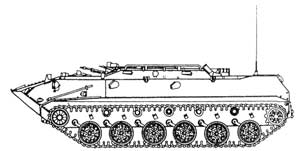 |
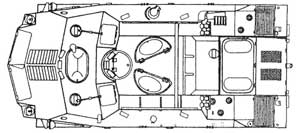 |
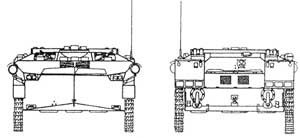 |
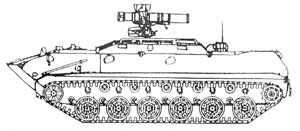 |
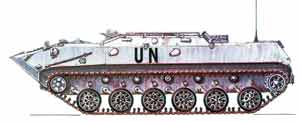 |
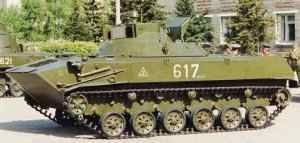 |
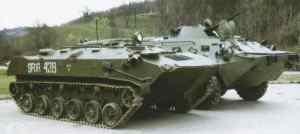 |
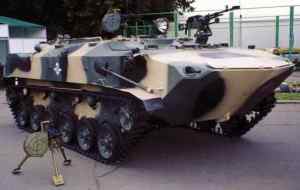 |
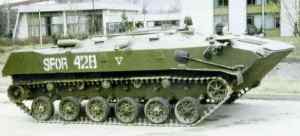 |
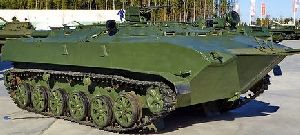 |
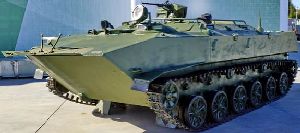 |






